Management Issues in Construction Industry
VerifiedAdded on 2021/05/31
|6
|2107
|43
AI Summary
Contribute Materials
Your contribution can guide someone’s learning journey. Share your
documents today.
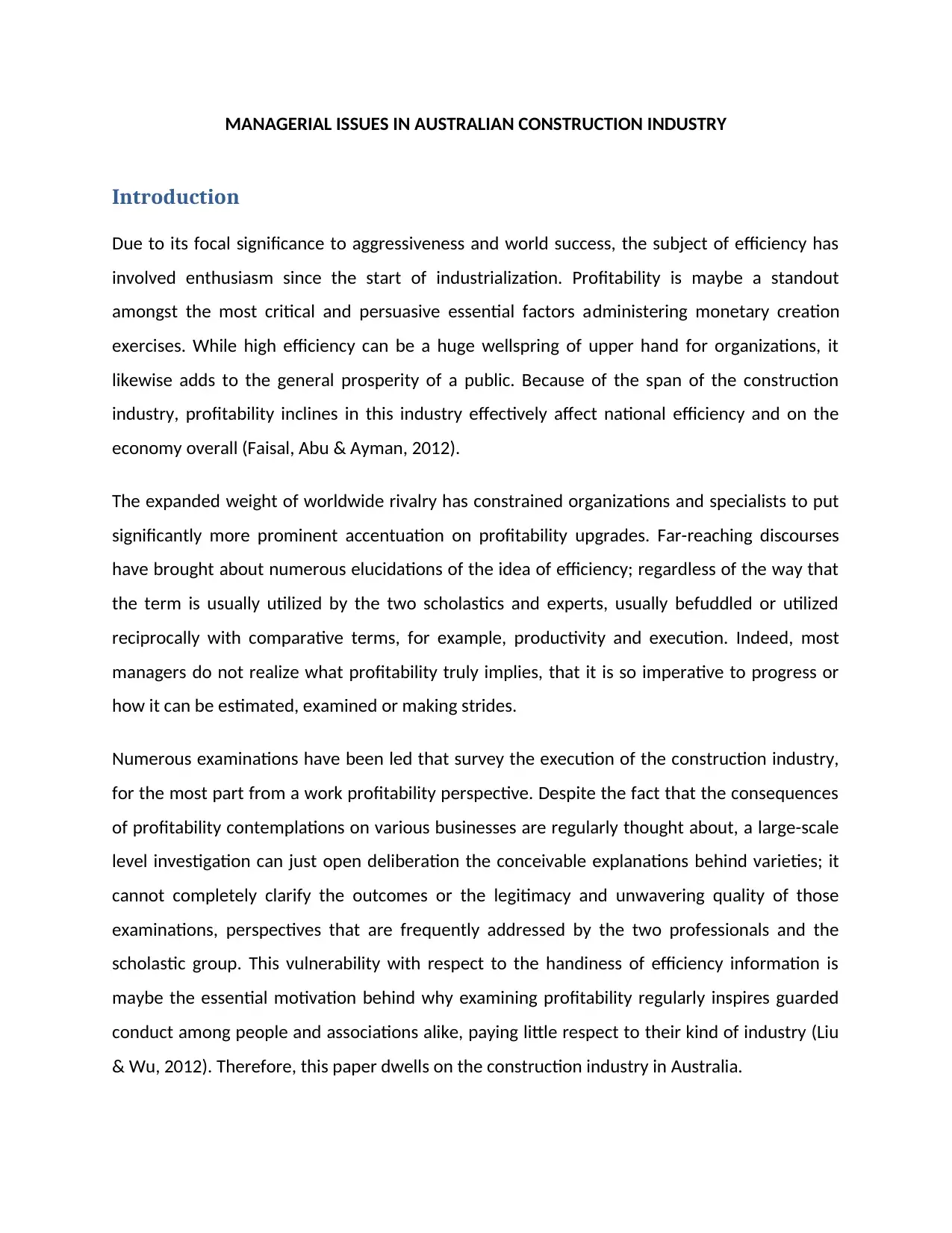
MANAGERIAL ISSUES IN AUSTRALIAN CONSTRUCTION INDUSTRY
Introduction
Due to its focal significance to aggressiveness and world success, the subject of efficiency has
involved enthusiasm since the start of industrialization. Profitability is maybe a standout
amongst the most critical and persuasive essential factors administering monetary creation
exercises. While high efficiency can be a huge wellspring of upper hand for organizations, it
likewise adds to the general prosperity of a public. Because of the span of the construction
industry, profitability inclines in this industry effectively affect national efficiency and on the
economy overall (Faisal, Abu & Ayman, 2012).
The expanded weight of worldwide rivalry has constrained organizations and specialists to put
significantly more prominent accentuation on profitability upgrades. Far-reaching discourses
have brought about numerous elucidations of the idea of efficiency; regardless of the way that
the term is usually utilized by the two scholastics and experts, usually befuddled or utilized
reciprocally with comparative terms, for example, productivity and execution. Indeed, most
managers do not realize what profitability truly implies, that it is so imperative to progress or
how it can be estimated, examined or making strides.
Numerous examinations have been led that survey the execution of the construction industry,
for the most part from a work profitability perspective. Despite the fact that the consequences
of profitability contemplations on various businesses are regularly thought about, a large-scale
level investigation can just open deliberation the conceivable explanations behind varieties; it
cannot completely clarify the outcomes or the legitimacy and unwavering quality of those
examinations, perspectives that are frequently addressed by the two professionals and the
scholastic group. This vulnerability with respect to the handiness of efficiency information is
maybe the essential motivation behind why examining profitability regularly inspires guarded
conduct among people and associations alike, paying little respect to their kind of industry (Liu
& Wu, 2012). Therefore, this paper dwells on the construction industry in Australia.
Introduction
Due to its focal significance to aggressiveness and world success, the subject of efficiency has
involved enthusiasm since the start of industrialization. Profitability is maybe a standout
amongst the most critical and persuasive essential factors administering monetary creation
exercises. While high efficiency can be a huge wellspring of upper hand for organizations, it
likewise adds to the general prosperity of a public. Because of the span of the construction
industry, profitability inclines in this industry effectively affect national efficiency and on the
economy overall (Faisal, Abu & Ayman, 2012).
The expanded weight of worldwide rivalry has constrained organizations and specialists to put
significantly more prominent accentuation on profitability upgrades. Far-reaching discourses
have brought about numerous elucidations of the idea of efficiency; regardless of the way that
the term is usually utilized by the two scholastics and experts, usually befuddled or utilized
reciprocally with comparative terms, for example, productivity and execution. Indeed, most
managers do not realize what profitability truly implies, that it is so imperative to progress or
how it can be estimated, examined or making strides.
Numerous examinations have been led that survey the execution of the construction industry,
for the most part from a work profitability perspective. Despite the fact that the consequences
of profitability contemplations on various businesses are regularly thought about, a large-scale
level investigation can just open deliberation the conceivable explanations behind varieties; it
cannot completely clarify the outcomes or the legitimacy and unwavering quality of those
examinations, perspectives that are frequently addressed by the two professionals and the
scholastic group. This vulnerability with respect to the handiness of efficiency information is
maybe the essential motivation behind why examining profitability regularly inspires guarded
conduct among people and associations alike, paying little respect to their kind of industry (Liu
& Wu, 2012). Therefore, this paper dwells on the construction industry in Australia.
Secure Best Marks with AI Grader
Need help grading? Try our AI Grader for instant feedback on your assignments.
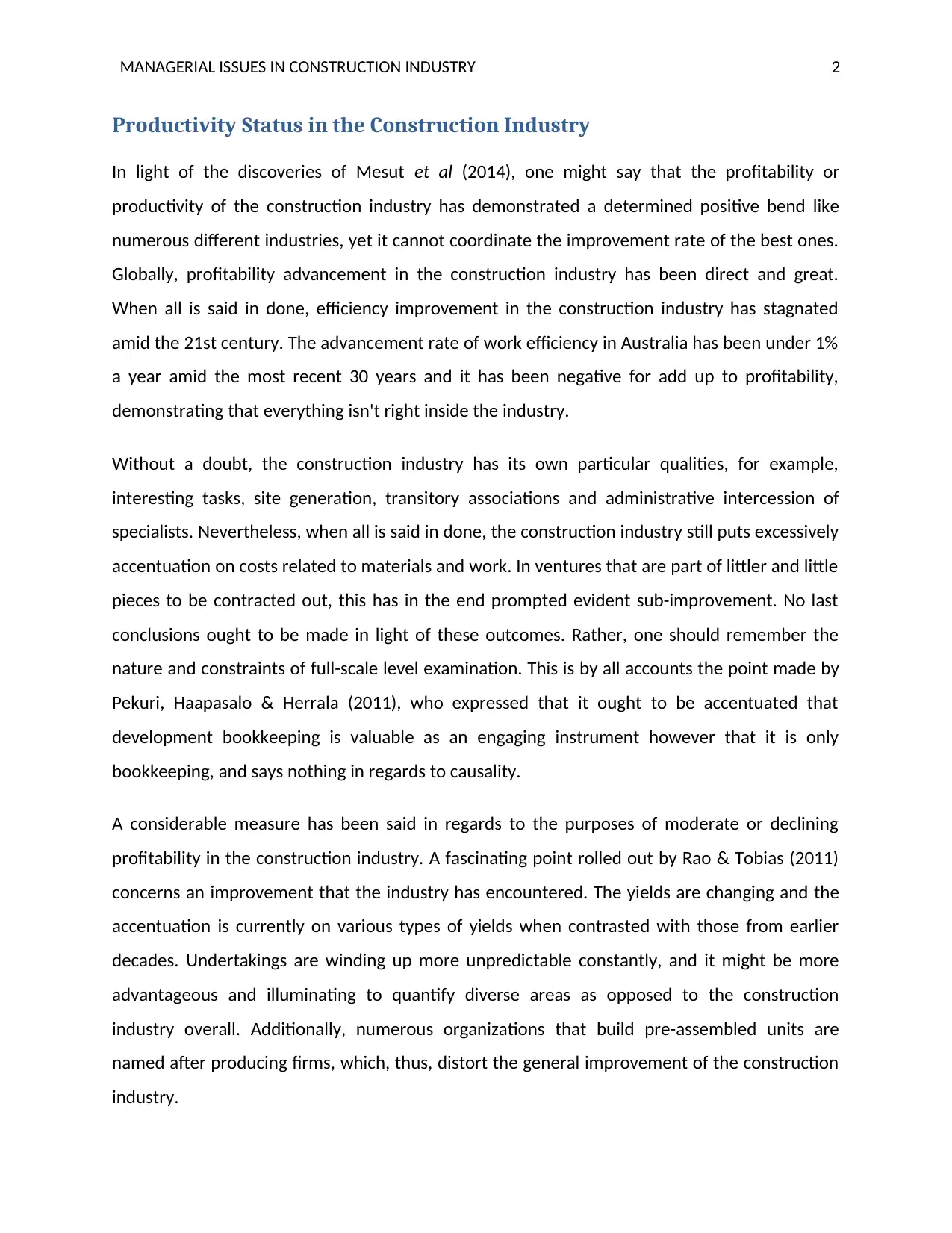
MANAGERIAL ISSUES IN CONSTRUCTION INDUSTRY 2
Productivity Status in the Construction Industry
In light of the discoveries of Mesut et al (2014), one might say that the profitability or
productivity of the construction industry has demonstrated a determined positive bend like
numerous different industries, yet it cannot coordinate the improvement rate of the best ones.
Globally, profitability advancement in the construction industry has been direct and great.
When all is said in done, efficiency improvement in the construction industry has stagnated
amid the 21st century. The advancement rate of work efficiency in Australia has been under 1%
a year amid the most recent 30 years and it has been negative for add up to profitability,
demonstrating that everything isn't right inside the industry.
Without a doubt, the construction industry has its own particular qualities, for example,
interesting tasks, site generation, transitory associations and administrative intercession of
specialists. Nevertheless, when all is said in done, the construction industry still puts excessively
accentuation on costs related to materials and work. In ventures that are part of littler and little
pieces to be contracted out, this has in the end prompted evident sub-improvement. No last
conclusions ought to be made in light of these outcomes. Rather, one should remember the
nature and constraints of full-scale level examination. This is by all accounts the point made by
Pekuri, Haapasalo & Herrala (2011), who expressed that it ought to be accentuated that
development bookkeeping is valuable as an engaging instrument however that it is only
bookkeeping, and says nothing in regards to causality.
A considerable measure has been said in regards to the purposes of moderate or declining
profitability in the construction industry. A fascinating point rolled out by Rao & Tobias (2011)
concerns an improvement that the industry has encountered. The yields are changing and the
accentuation is currently on various types of yields when contrasted with those from earlier
decades. Undertakings are winding up more unpredictable constantly, and it might be more
advantageous and illuminating to quantify diverse areas as opposed to the construction
industry overall. Additionally, numerous organizations that build pre-assembled units are
named after producing firms, which, thus, distort the general improvement of the construction
industry.
Productivity Status in the Construction Industry
In light of the discoveries of Mesut et al (2014), one might say that the profitability or
productivity of the construction industry has demonstrated a determined positive bend like
numerous different industries, yet it cannot coordinate the improvement rate of the best ones.
Globally, profitability advancement in the construction industry has been direct and great.
When all is said in done, efficiency improvement in the construction industry has stagnated
amid the 21st century. The advancement rate of work efficiency in Australia has been under 1%
a year amid the most recent 30 years and it has been negative for add up to profitability,
demonstrating that everything isn't right inside the industry.
Without a doubt, the construction industry has its own particular qualities, for example,
interesting tasks, site generation, transitory associations and administrative intercession of
specialists. Nevertheless, when all is said in done, the construction industry still puts excessively
accentuation on costs related to materials and work. In ventures that are part of littler and little
pieces to be contracted out, this has in the end prompted evident sub-improvement. No last
conclusions ought to be made in light of these outcomes. Rather, one should remember the
nature and constraints of full-scale level examination. This is by all accounts the point made by
Pekuri, Haapasalo & Herrala (2011), who expressed that it ought to be accentuated that
development bookkeeping is valuable as an engaging instrument however that it is only
bookkeeping, and says nothing in regards to causality.
A considerable measure has been said in regards to the purposes of moderate or declining
profitability in the construction industry. A fascinating point rolled out by Rao & Tobias (2011)
concerns an improvement that the industry has encountered. The yields are changing and the
accentuation is currently on various types of yields when contrasted with those from earlier
decades. Undertakings are winding up more unpredictable constantly, and it might be more
advantageous and illuminating to quantify diverse areas as opposed to the construction
industry overall. Additionally, numerous organizations that build pre-assembled units are
named after producing firms, which, thus, distort the general improvement of the construction
industry.
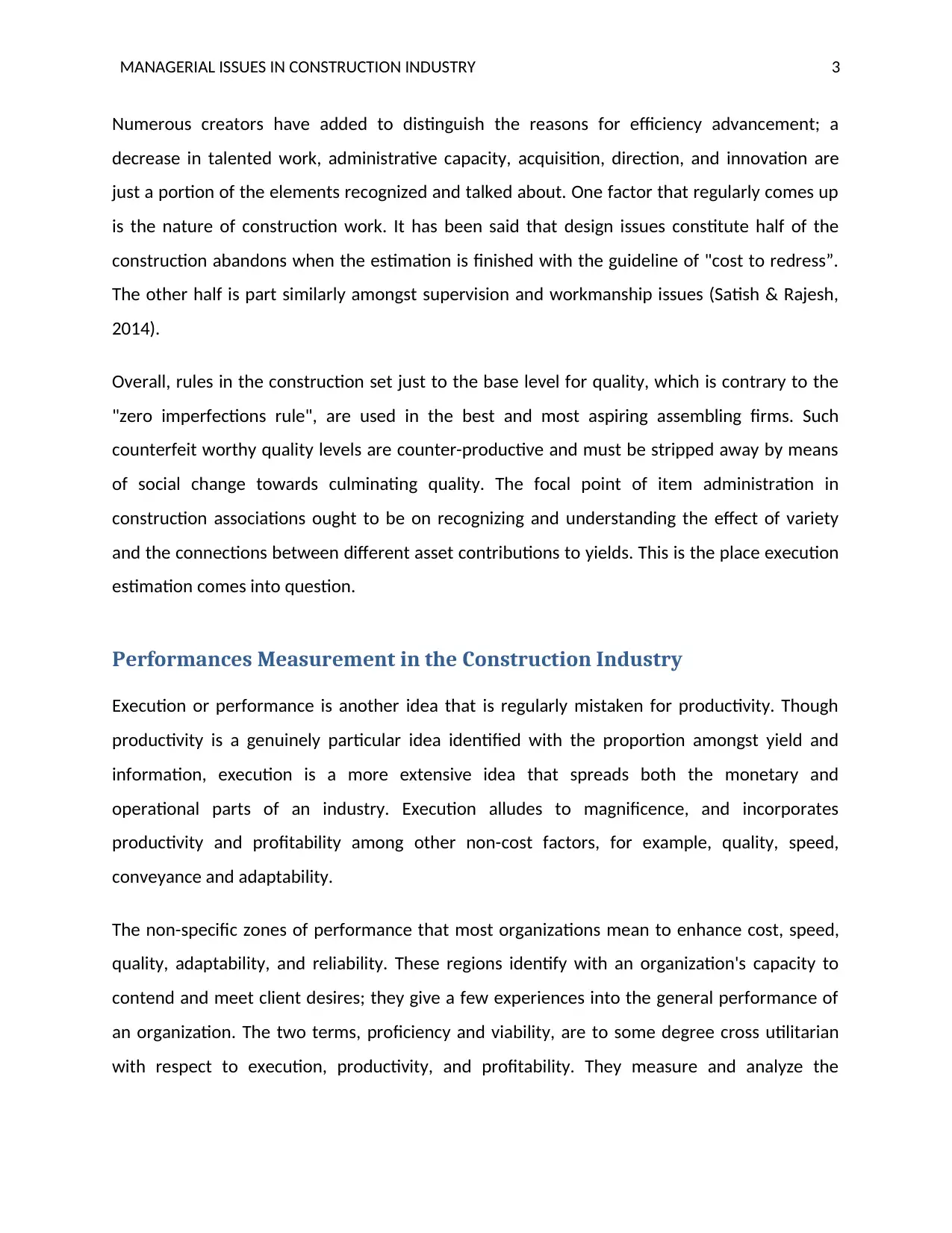
MANAGERIAL ISSUES IN CONSTRUCTION INDUSTRY 3
Numerous creators have added to distinguish the reasons for efficiency advancement; a
decrease in talented work, administrative capacity, acquisition, direction, and innovation are
just a portion of the elements recognized and talked about. One factor that regularly comes up
is the nature of construction work. It has been said that design issues constitute half of the
construction abandons when the estimation is finished with the guideline of "cost to redress”.
The other half is part similarly amongst supervision and workmanship issues (Satish & Rajesh,
2014).
Overall, rules in the construction set just to the base level for quality, which is contrary to the
"zero imperfections rule", are used in the best and most aspiring assembling firms. Such
counterfeit worthy quality levels are counter-productive and must be stripped away by means
of social change towards culminating quality. The focal point of item administration in
construction associations ought to be on recognizing and understanding the effect of variety
and the connections between different asset contributions to yields. This is the place execution
estimation comes into question.
Performances Measurement in the Construction Industry
Execution or performance is another idea that is regularly mistaken for productivity. Though
productivity is a genuinely particular idea identified with the proportion amongst yield and
information, execution is a more extensive idea that spreads both the monetary and
operational parts of an industry. Execution alludes to magnificence, and incorporates
productivity and profitability among other non-cost factors, for example, quality, speed,
conveyance and adaptability.
The non-specific zones of performance that most organizations mean to enhance cost, speed,
quality, adaptability, and reliability. These regions identify with an organization's capacity to
contend and meet client desires; they give a few experiences into the general performance of
an organization. The two terms, proficiency and viability, are to some degree cross utilitarian
with respect to execution, productivity, and profitability. They measure and analyze the
Numerous creators have added to distinguish the reasons for efficiency advancement; a
decrease in talented work, administrative capacity, acquisition, direction, and innovation are
just a portion of the elements recognized and talked about. One factor that regularly comes up
is the nature of construction work. It has been said that design issues constitute half of the
construction abandons when the estimation is finished with the guideline of "cost to redress”.
The other half is part similarly amongst supervision and workmanship issues (Satish & Rajesh,
2014).
Overall, rules in the construction set just to the base level for quality, which is contrary to the
"zero imperfections rule", are used in the best and most aspiring assembling firms. Such
counterfeit worthy quality levels are counter-productive and must be stripped away by means
of social change towards culminating quality. The focal point of item administration in
construction associations ought to be on recognizing and understanding the effect of variety
and the connections between different asset contributions to yields. This is the place execution
estimation comes into question.
Performances Measurement in the Construction Industry
Execution or performance is another idea that is regularly mistaken for productivity. Though
productivity is a genuinely particular idea identified with the proportion amongst yield and
information, execution is a more extensive idea that spreads both the monetary and
operational parts of an industry. Execution alludes to magnificence, and incorporates
productivity and profitability among other non-cost factors, for example, quality, speed,
conveyance and adaptability.
The non-specific zones of performance that most organizations mean to enhance cost, speed,
quality, adaptability, and reliability. These regions identify with an organization's capacity to
contend and meet client desires; they give a few experiences into the general performance of
an organization. The two terms, proficiency and viability, are to some degree cross utilitarian
with respect to execution, productivity, and profitability. They measure and analyze the
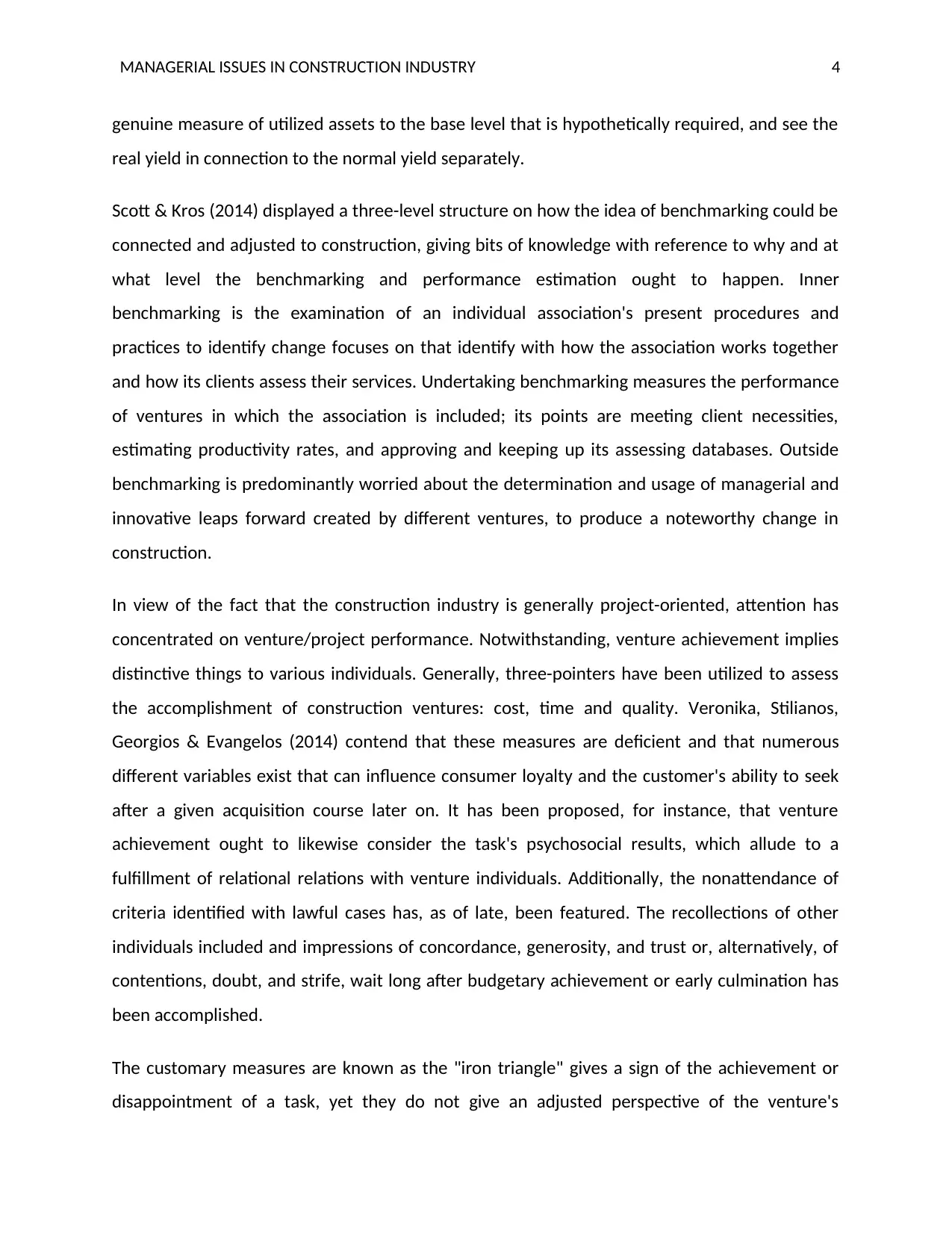
MANAGERIAL ISSUES IN CONSTRUCTION INDUSTRY 4
genuine measure of utilized assets to the base level that is hypothetically required, and see the
real yield in connection to the normal yield separately.
Scott & Kros (2014) displayed a three-level structure on how the idea of benchmarking could be
connected and adjusted to construction, giving bits of knowledge with reference to why and at
what level the benchmarking and performance estimation ought to happen. Inner
benchmarking is the examination of an individual association's present procedures and
practices to identify change focuses on that identify with how the association works together
and how its clients assess their services. Undertaking benchmarking measures the performance
of ventures in which the association is included; its points are meeting client necessities,
estimating productivity rates, and approving and keeping up its assessing databases. Outside
benchmarking is predominantly worried about the determination and usage of managerial and
innovative leaps forward created by different ventures, to produce a noteworthy change in
construction.
In view of the fact that the construction industry is generally project-oriented, attention has
concentrated on venture/project performance. Notwithstanding, venture achievement implies
distinctive things to various individuals. Generally, three-pointers have been utilized to assess
the accomplishment of construction ventures: cost, time and quality. Veronika, Stilianos,
Georgios & Evangelos (2014) contend that these measures are deficient and that numerous
different variables exist that can influence consumer loyalty and the customer's ability to seek
after a given acquisition course later on. It has been proposed, for instance, that venture
achievement ought to likewise consider the task's psychosocial results, which allude to a
fulfillment of relational relations with venture individuals. Additionally, the nonattendance of
criteria identified with lawful cases has, as of late, been featured. The recollections of other
individuals included and impressions of concordance, generosity, and trust or, alternatively, of
contentions, doubt, and strife, wait long after budgetary achievement or early culmination has
been accomplished.
The customary measures are known as the "iron triangle" gives a sign of the achievement or
disappointment of a task, yet they do not give an adjusted perspective of the venture's
genuine measure of utilized assets to the base level that is hypothetically required, and see the
real yield in connection to the normal yield separately.
Scott & Kros (2014) displayed a three-level structure on how the idea of benchmarking could be
connected and adjusted to construction, giving bits of knowledge with reference to why and at
what level the benchmarking and performance estimation ought to happen. Inner
benchmarking is the examination of an individual association's present procedures and
practices to identify change focuses on that identify with how the association works together
and how its clients assess their services. Undertaking benchmarking measures the performance
of ventures in which the association is included; its points are meeting client necessities,
estimating productivity rates, and approving and keeping up its assessing databases. Outside
benchmarking is predominantly worried about the determination and usage of managerial and
innovative leaps forward created by different ventures, to produce a noteworthy change in
construction.
In view of the fact that the construction industry is generally project-oriented, attention has
concentrated on venture/project performance. Notwithstanding, venture achievement implies
distinctive things to various individuals. Generally, three-pointers have been utilized to assess
the accomplishment of construction ventures: cost, time and quality. Veronika, Stilianos,
Georgios & Evangelos (2014) contend that these measures are deficient and that numerous
different variables exist that can influence consumer loyalty and the customer's ability to seek
after a given acquisition course later on. It has been proposed, for instance, that venture
achievement ought to likewise consider the task's psychosocial results, which allude to a
fulfillment of relational relations with venture individuals. Additionally, the nonattendance of
criteria identified with lawful cases has, as of late, been featured. The recollections of other
individuals included and impressions of concordance, generosity, and trust or, alternatively, of
contentions, doubt, and strife, wait long after budgetary achievement or early culmination has
been accomplished.
The customary measures are known as the "iron triangle" gives a sign of the achievement or
disappointment of a task, yet they do not give an adjusted perspective of the venture's
Secure Best Marks with AI Grader
Need help grading? Try our AI Grader for instant feedback on your assignments.
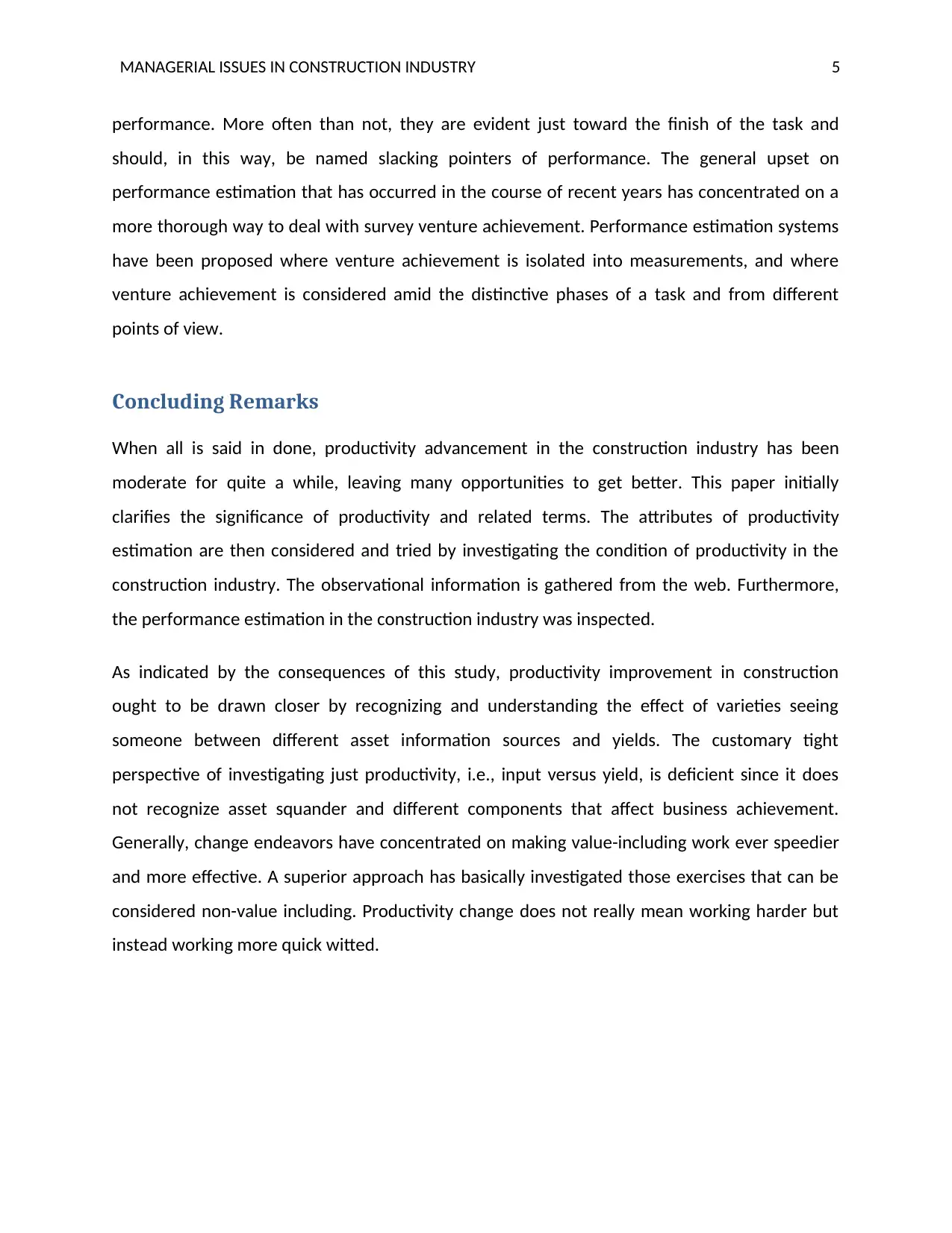
MANAGERIAL ISSUES IN CONSTRUCTION INDUSTRY 5
performance. More often than not, they are evident just toward the finish of the task and
should, in this way, be named slacking pointers of performance. The general upset on
performance estimation that has occurred in the course of recent years has concentrated on a
more thorough way to deal with survey venture achievement. Performance estimation systems
have been proposed where venture achievement is isolated into measurements, and where
venture achievement is considered amid the distinctive phases of a task and from different
points of view.
Concluding Remarks
When all is said in done, productivity advancement in the construction industry has been
moderate for quite a while, leaving many opportunities to get better. This paper initially
clarifies the significance of productivity and related terms. The attributes of productivity
estimation are then considered and tried by investigating the condition of productivity in the
construction industry. The observational information is gathered from the web. Furthermore,
the performance estimation in the construction industry was inspected.
As indicated by the consequences of this study, productivity improvement in construction
ought to be drawn closer by recognizing and understanding the effect of varieties seeing
someone between different asset information sources and yields. The customary tight
perspective of investigating just productivity, i.e., input versus yield, is deficient since it does
not recognize asset squander and different components that affect business achievement.
Generally, change endeavors have concentrated on making value-including work ever speedier
and more effective. A superior approach has basically investigated those exercises that can be
considered non-value including. Productivity change does not really mean working harder but
instead working more quick witted.
performance. More often than not, they are evident just toward the finish of the task and
should, in this way, be named slacking pointers of performance. The general upset on
performance estimation that has occurred in the course of recent years has concentrated on a
more thorough way to deal with survey venture achievement. Performance estimation systems
have been proposed where venture achievement is isolated into measurements, and where
venture achievement is considered amid the distinctive phases of a task and from different
points of view.
Concluding Remarks
When all is said in done, productivity advancement in the construction industry has been
moderate for quite a while, leaving many opportunities to get better. This paper initially
clarifies the significance of productivity and related terms. The attributes of productivity
estimation are then considered and tried by investigating the condition of productivity in the
construction industry. The observational information is gathered from the web. Furthermore,
the performance estimation in the construction industry was inspected.
As indicated by the consequences of this study, productivity improvement in construction
ought to be drawn closer by recognizing and understanding the effect of varieties seeing
someone between different asset information sources and yields. The customary tight
perspective of investigating just productivity, i.e., input versus yield, is deficient since it does
not recognize asset squander and different components that affect business achievement.
Generally, change endeavors have concentrated on making value-including work ever speedier
and more effective. A superior approach has basically investigated those exercises that can be
considered non-value including. Productivity change does not really mean working harder but
instead working more quick witted.
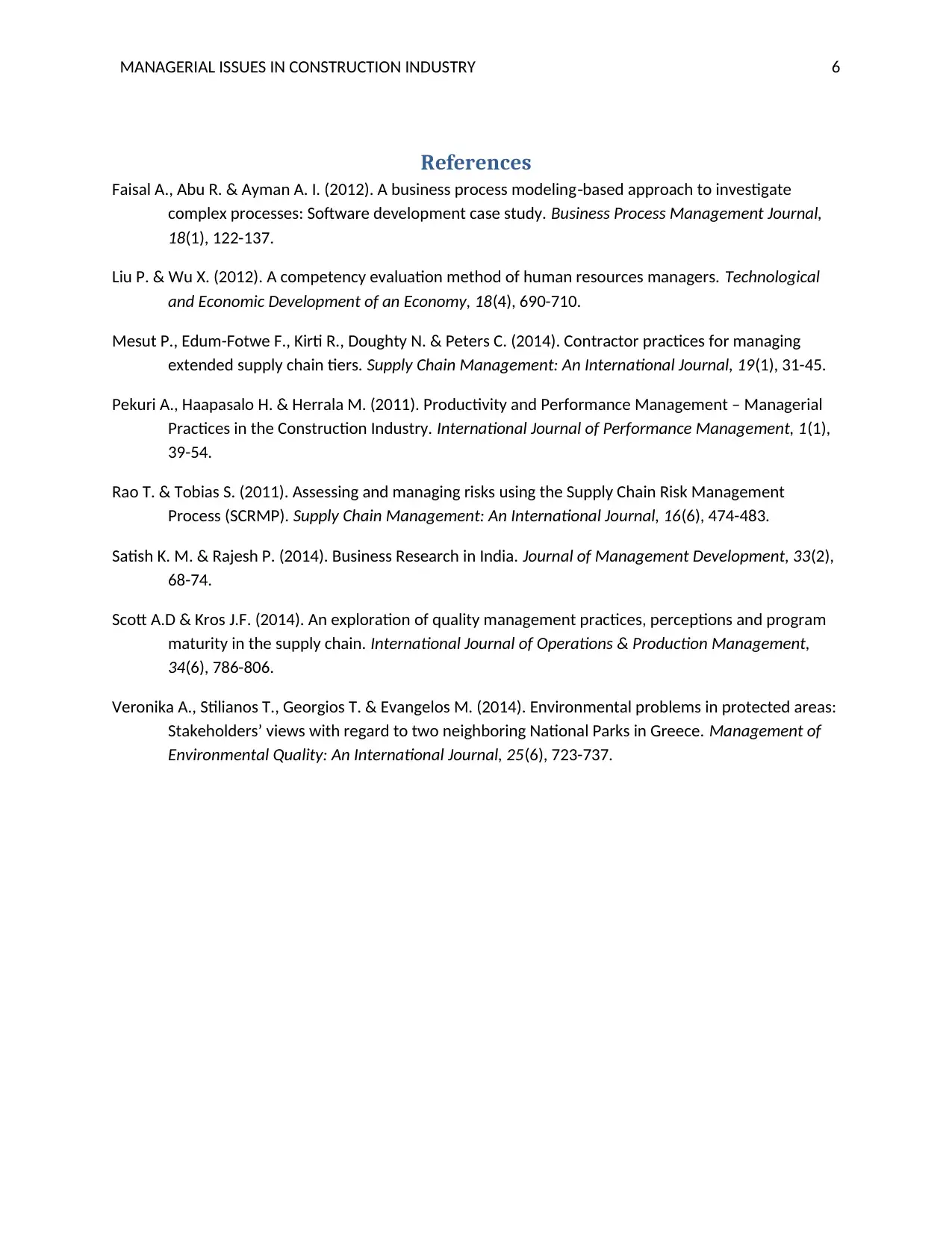
MANAGERIAL ISSUES IN CONSTRUCTION INDUSTRY 6
References
Faisal A., Abu R. & Ayman A. I. (2012). A business process modeling based approach to investigate‐
complex processes: Software development case study. Business Process Management Journal,
18(1), 122-137.
Liu P. & Wu X. (2012). A competency evaluation method of human resources managers. Technological
and Economic Development of an Economy, 18(4), 690-710.
Mesut P., Edum-Fotwe F., Kirti R., Doughty N. & Peters C. (2014). Contractor practices for managing
extended supply chain tiers. Supply Chain Management: An International Journal, 19(1), 31-45.
Pekuri A., Haapasalo H. & Herrala M. (2011). Productivity and Performance Management – Managerial
Practices in the Construction Industry. International Journal of Performance Management, 1(1),
39-54.
Rao T. & Tobias S. (2011). Assessing and managing risks using the Supply Chain Risk Management
Process (SCRMP). Supply Chain Management: An International Journal, 16(6), 474-483.
Satish K. M. & Rajesh P. (2014). Business Research in India. Journal of Management Development, 33(2),
68-74.
Scott A.D & Kros J.F. (2014). An exploration of quality management practices, perceptions and program
maturity in the supply chain. International Journal of Operations & Production Management,
34(6), 786-806.
Veronika A., Stilianos T., Georgios T. & Evangelos M. (2014). Environmental problems in protected areas:
Stakeholders’ views with regard to two neighboring National Parks in Greece. Management of
Environmental Quality: An International Journal, 25(6), 723-737.
References
Faisal A., Abu R. & Ayman A. I. (2012). A business process modeling based approach to investigate‐
complex processes: Software development case study. Business Process Management Journal,
18(1), 122-137.
Liu P. & Wu X. (2012). A competency evaluation method of human resources managers. Technological
and Economic Development of an Economy, 18(4), 690-710.
Mesut P., Edum-Fotwe F., Kirti R., Doughty N. & Peters C. (2014). Contractor practices for managing
extended supply chain tiers. Supply Chain Management: An International Journal, 19(1), 31-45.
Pekuri A., Haapasalo H. & Herrala M. (2011). Productivity and Performance Management – Managerial
Practices in the Construction Industry. International Journal of Performance Management, 1(1),
39-54.
Rao T. & Tobias S. (2011). Assessing and managing risks using the Supply Chain Risk Management
Process (SCRMP). Supply Chain Management: An International Journal, 16(6), 474-483.
Satish K. M. & Rajesh P. (2014). Business Research in India. Journal of Management Development, 33(2),
68-74.
Scott A.D & Kros J.F. (2014). An exploration of quality management practices, perceptions and program
maturity in the supply chain. International Journal of Operations & Production Management,
34(6), 786-806.
Veronika A., Stilianos T., Georgios T. & Evangelos M. (2014). Environmental problems in protected areas:
Stakeholders’ views with regard to two neighboring National Parks in Greece. Management of
Environmental Quality: An International Journal, 25(6), 723-737.
1 out of 6
Your All-in-One AI-Powered Toolkit for Academic Success.
+13062052269
info@desklib.com
Available 24*7 on WhatsApp / Email
![[object Object]](/_next/static/media/star-bottom.7253800d.svg)
Unlock your academic potential
© 2024 | Zucol Services PVT LTD | All rights reserved.
